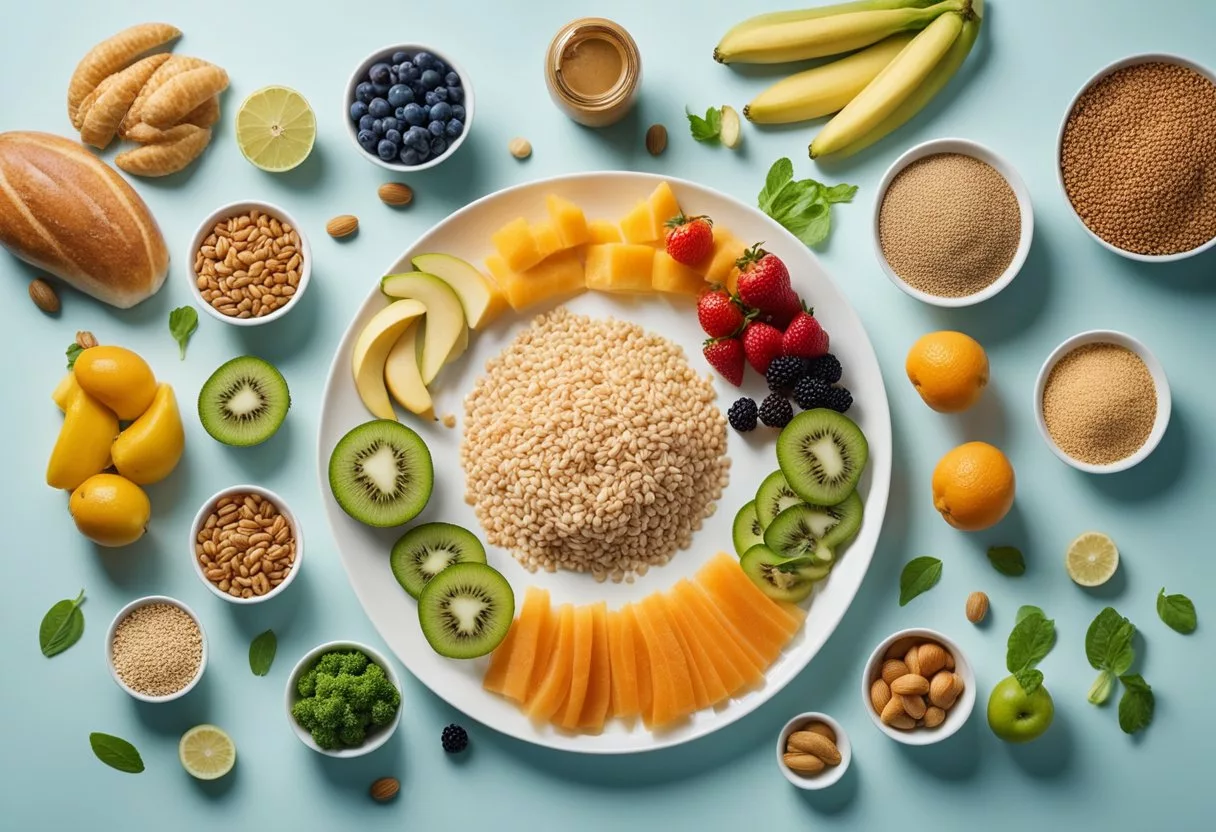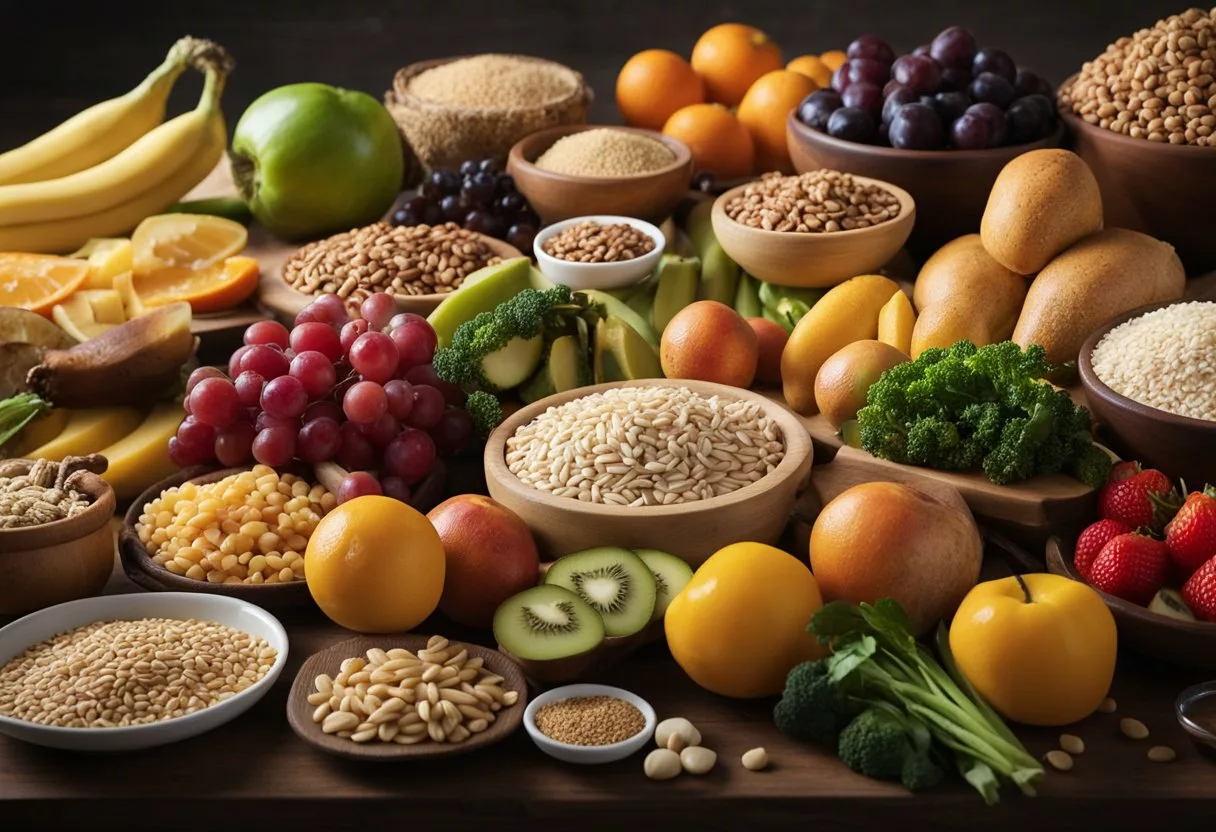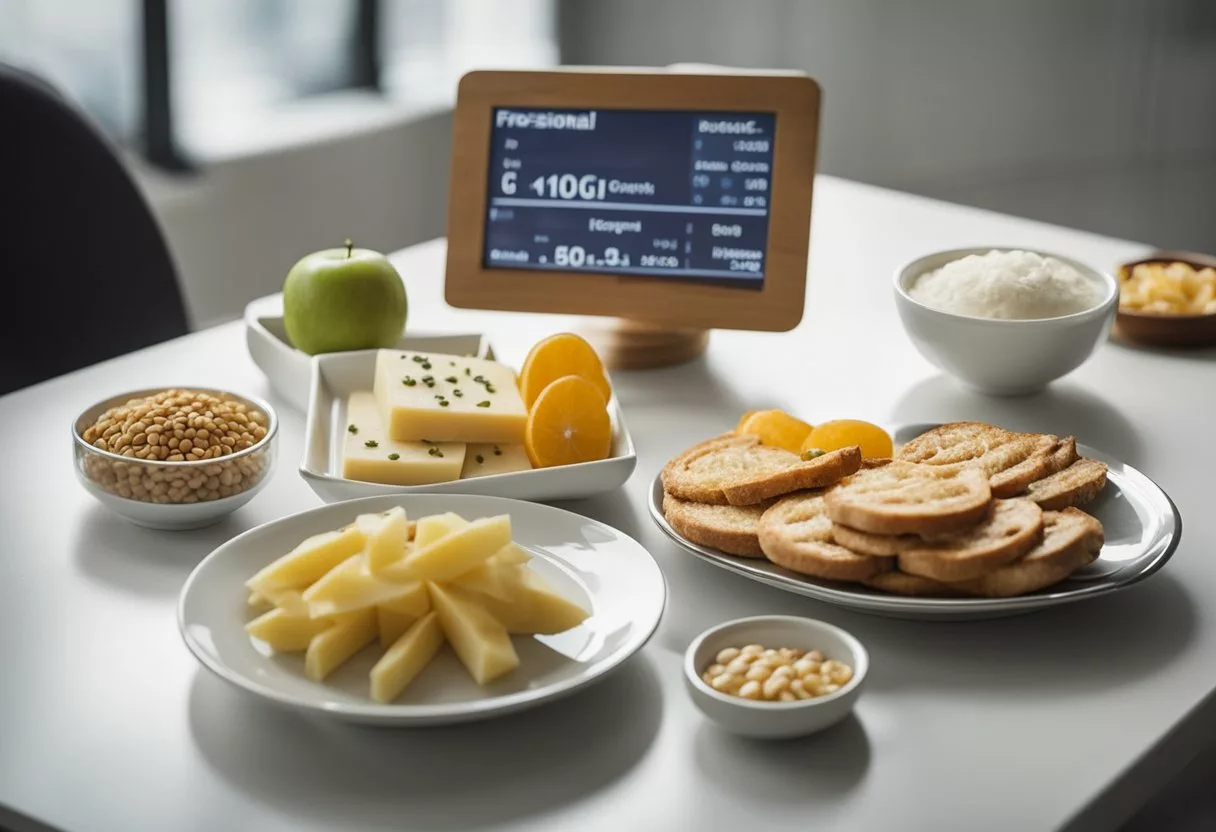The glycemic index (GI) plays a key role in our body’s hormonal balance. It measures how fast foods raise blood sugar levels. Foods with a high GI can cause quick spikes in blood sugar, leading to hormonal shifts.

【Sugar Defender™】Buy Now $69 | SugarDefender Official Site
Buy Now Sugar Defender — Sugar Defender 100% Natural Formula. 60 Day Guarantee. Free Shipping. Only $49 per Bottle. Blood Sugar Defender Order 6 Bottles or 3 Bottles and Get 2 Free Bonuses.
Eating foods with a lower glycemic index can help maintain steady hormone levels throughout the day. This is because low GI foods are digested more slowly, resulting in a gradual release of glucose into the bloodstream. This steady release helps keep insulin and other hormone levels more stable.
Choosing low GI foods can be a simple yet effective way to support hormonal health. By focusing on whole grains, fruits, vegetables, and lean proteins, people can create meals that promote hormonal balance. The glycemic index of common foods can be a helpful guide for making these choices.
Key Takeaways
- The glycemic index measures how quickly foods raise blood sugar levels
- Low GI foods can help maintain steady hormone levels
- Choosing whole foods and lean proteins supports hormonal balance
Understanding Glycemic Index

The glycemic index helps people manage blood sugar levels. It ranks foods based on how they affect glucose in the body.
Definition and Importance
The glycemic index (GI) is a scale that rates foods from 0 to 100 based on how quickly they raise blood sugar. Foods with a high GI are digested fast and cause a rapid spike in blood glucose. Low GI foods are absorbed more slowly, leading to a gradual rise in blood sugar.
The GI is important for: • Blood sugar control • Weight management • Heart health • Energy levels
Understanding the GI can help people make better food choices. It’s especially useful for those with diabetes or trying to lose weight.
Glycemic Index (GI) Versus Glycemic Load
While the GI measures how quickly a food raises blood sugar, glycemic load (GL) takes into account both the GI and the amount of carbs in a serving.
GL = (GI x grams of carbs) / 100
The GL gives a more complete picture of a food’s impact on blood sugar. A food may have a high GI but a low GL if the serving size is small.
For example, watermelon has a high GI but a low GL because it contains mostly water.
Factors Influencing GI Values of Foods
Several factors can affect a food’s GI value:
- Fiber content: High-fiber foods tend to have lower GI values.
- Fat and protein: These nutrients can slow digestion and lower the GI.
- Cooking method: Longer cooking times can increase GI.
- Ripeness: Riper fruits often have higher GI values.
- Processing: More processed foods usually have higher GIs.
- Particle size: Finely ground flour has a higher GI than whole grains.
The glycemic response can also vary between individuals. Factors like insulin sensitivity and gut bacteria can influence how someone reacts to different foods.
Role of Glycemic Index in Hormonal Regulation
The glycemic index affects hormone levels in the body. It changes insulin production and impacts other hormones related to blood sugar control.
Impact on Insulin Levels
The glycemic index (GI) influences insulin secretion after meals. Foods with a high GI cause blood sugar to rise quickly. This triggers a large insulin release from the pancreas.
Low GI foods lead to a slower, more steady rise in blood sugar. The body releases less insulin in response. Over time, high GI diets may cause the pancreas to overproduce insulin.
Eating mostly low GI foods can help keep insulin levels more stable. This is better for long-term hormonal health.
Insulin Resistance and Hormonal Imbalance
Eating too many high GI foods can lead to insulin resistance. This happens when cells stop responding well to insulin. The body then makes more insulin to try to control blood sugar.
High insulin levels can upset the balance of other hormones. It may increase testosterone in women and decrease it in men. This can cause issues like acne or fertility problems.
Insulin resistance also affects hormones that control hunger and fullness. It can make people feel hungry even when they’ve eaten enough.
Blood Sugar Control and Hormone Production
Stable blood sugar helps the body make hormones properly. Wild swings in blood sugar can disrupt hormone production.
Low GI diets help keep blood sugar steady. This supports the healthy production of hormones like cortisol and growth hormone.
Good blood sugar control also helps thyroid function. The thyroid gland needs steady energy to make its hormones. Eating low GI foods provides this steady energy supply.
Balanced blood sugar may even improve mood. It helps the brain make serotonin, which affects emotions.
The Hormonal Impact of Different Foods
Food choices play a big role in hormone balance. What we eat affects insulin, cortisol, and other key hormones. Some foods help keep hormones stable, while others can throw them off.
Understanding Macronutrients and Hormones
Proteins, fats, and carbs each affect hormones differently. Protein helps build hormones and keeps blood sugar steady. Good sources are fish, eggs, and beans.
Fats are needed to make some hormones. Healthy fats like those in nuts and fish support hormone health. Too little fat can lead to hormone problems.
Carbs have the biggest effect on insulin. Simple carbs like sugar cause quick insulin spikes. Complex carbs from vegetables and whole grains are better for steady insulin levels.
Fiber is important for hormone balance too. It slows digestion and helps remove excess hormones from the body.
Foods that Promote Hormonal Health
Some foods are especially good for hormones. Fatty fish like salmon provide omega-3s that reduce inflammation and support hormone production.
Cruciferous veggies such as broccoli and kale help the body process extra estrogen. This promotes balance between different hormones.
Nuts and seeds offer healthy fats and minerals that support hormone health. Almonds and pumpkin seeds are good choices.
Berries are rich in antioxidants that protect hormone-producing glands. They also have fiber to help regulate blood sugar.
Chickpeas and other legumes provide B vitamins that help make neurotransmitters like serotonin.
Foods and Habits to Avoid
Some foods can disrupt hormones. Sugary foods and drinks cause insulin spikes and crashes. This can lead to insulin resistance over time.
Processed foods often contain unhealthy fats and additives that interfere with hormones. They’re best limited or avoided.
Too much caffeine can increase stress hormones like cortisol. It’s wise to stick to moderate amounts.
Alcohol can mess with many hormones. It affects insulin, cortisol, and sex hormones. Limiting intake supports better hormone balance.
Lack of sleep and high stress also hurt hormone health. Getting enough rest and managing stress are key habits for hormonal balance.
Dietary Strategies for Balancing Hormones

Food choices play a key role in maintaining hormonal balance. Certain eating habits can help regulate blood sugar and reduce inflammation, supporting overall hormonal health.
Low Glycemic Index Diet and Hormonal Equilibrium
A low glycemic index (GI) diet can help balance hormones by keeping blood sugar levels stable. Foods with a lower GI are digested more slowly, leading to a gradual rise in blood sugar. This can help regulate insulin, a hormone that affects many other hormones in the body.
Some low GI foods include:
- Whole grains
- Legumes
- Non-starchy vegetables
- Some fruits
Pairing carbohydrates with protein or healthy fats can further lower the glycemic impact of meals. For example, eating an apple with almond butter can slow down sugar absorption.
Incorporating Anti-inflammatory Foods
Chronic inflammation can disrupt hormone function. Eating anti-inflammatory foods may help restore balance. These foods are often rich in antioxidants, which protect cells from damage.
Anti-inflammatory foods to include:
- Fatty fish (salmon, sardines)
- Leafy greens
- Berries
- Nuts and seeds
- Olive oil
Turmeric, ginger, and green tea also have potent anti-inflammatory properties. Omega-3 fats found in fish and some plant sources can help regulate hormones and reduce inflammation.
Importance of Micronutrients
Vitamins and minerals play crucial roles in hormone production and function. A diet rich in diverse, nutrient-dense foods can provide these essential micronutrients.
Key micronutrients for hormone balance:
- Vitamin D: Found in fatty fish, egg yolks, and sunlight exposure
- B vitamins: Present in whole grains, leafy greens, and lean meats
- Magnesium: Abundant in nuts, seeds, and dark chocolate
- Zinc: Found in oysters, beef, and pumpkin seeds
- Iodine: Present in seaweed, fish, and iodized salt
Fiber-rich foods like fruits, vegetables, and whole grains can also support hormonal health by promoting healthy digestion and gut bacteria balance.
Glycemic Index and Specific Hormonal Conditions

The glycemic index plays a key role in managing various hormonal conditions. It affects blood sugar levels, which in turn impact hormone balance throughout the body.
Diabetes and Blood Sugar Management
Glycemic index is really important for diabetes management. Low GI foods help control blood sugar spikes. This is important for both Type 1 and Type 2 diabetes.
People with diabetes should focus on low GI foods like:
- Whole grains
- Legumes
- Non-starchy vegetables
These foods release glucose slowly into the bloodstream. This leads to better blood sugar control and less strain on the pancreas to produce insulin.
High GI foods can cause rapid blood sugar spikes. These should be limited in a diabetic diet. Examples include:
- White bread
- Sugary snacks
- Soft drinks
Polycystic Ovary Syndrome (PCOS) and Diet
PCOS is linked to insulin resistance. A low GI diet can help manage PCOS symptoms. It may improve hormone balance and reduce insulin levels.
Women with PCOS often benefit from eating:
- Lean proteins
- Healthy fats
- Low GI carbohydrates
This diet approach can help regulate menstrual cycles and improve fertility. It may also aid in weight management, which is often a challenge with PCOS.
Avoiding high GI foods can reduce testosterone levels in women with PCOS. This can help decrease unwanted hair growth and acne.
Impact on Menstrual Cycle and Fertility
The glycemic index of foods can affect the menstrual cycle and fertility. High GI diets may lead to hormonal imbalances. These imbalances can disrupt regular menstrual cycles.
Low GI diets can help:
- Stabilize blood sugar
- Reduce inflammation
- Balance reproductive hormones
This can lead to more regular periods and improved fertility. Women trying to conceive may benefit from a low GI diet. It can help create a more favorable environment for conception.
Hormonal Imbalances and Weight Management
Weight gain is often linked to hormonal imbalances. A low GI diet can help manage weight by:
- Reducing hunger
- Controlling insulin levels
- Improving metabolism
Studies suggest that low GI diets may help prevent type 2 diabetes. This is partly due to their effect on weight management.
Hormones like cortisol and ghrelin are influenced by blood sugar levels. A stable blood sugar helps keep these hormones in check. This can reduce stress-related eating and improve overall hormonal balance.
Choosing low GI foods can lead to better satiety. This helps prevent overeating and supports long-term weight management.
Lifestyle and Environmental Factors

Our daily habits and surroundings play a big role in hormone balance. What we do and what’s around us can affect how our hormones work.
Exercise and Hormonal Health
Regular exercise helps keep hormones in check. It can boost good hormones and lower bad ones. Cardio and strength training are both important.
Cardio like running or swimming helps control stress hormones. It can lower cortisol levels over time. This helps with sleep and mood.
Strength training builds muscle. It raises testosterone and growth hormone levels. These hormones help burn fat and build strength.
Too much exercise can harm hormones. Overtraining may lead to fertility problems in some people. It’s key to find the right balance for your body.
Stress, Sleep, and Hormonal Balance
Stress and poor sleep can throw hormones off. Chronic stress raises cortisol levels. This can lead to weight gain and mood swings.
Good sleep is vital for hormone health. The body makes and regulates hormones during sleep. Aim for 7-9 hours each night.
Relaxation techniques can help manage stress. Try deep breathing, yoga, or meditation. These can lower cortisol and improve overall hormone balance.
Environmental Disruptors and Hormones
Some chemicals in our environment can mess with hormones. These are called endocrine disruptors. They can be found in plastics, pesticides, and personal care products.
Common endocrine disruptors include:
- BPA in plastic containers
- Phthalates in fragrances
- Pesticides on non-organic produce
To reduce exposure:
- Use glass containers for food storage
- Choose natural personal care products
- Buy organic produce when possible
Limiting contact with these chemicals can help protect hormone health. It’s part of creating a healthier overall environment for our bodies.
Frequently Asked Questions

The glycemic index plays a crucial role in managing hormonal balance and blood sugar levels. It affects various aspects of health, including PCOS symptoms, diabetes management, and appetite control.
What are the benefits of a low glycemic index diet for managing PCOS symptoms?
A low glycemic index diet can help manage PCOS symptoms by stabilizing blood sugar levels. This stabilization reduces insulin spikes, which can improve hormone balance.
Low-GI foods like sweet potatoes provide steady energy without causing rapid blood sugar increases. These foods can also help regulate menstrual cycles and reduce inflammation associated with PCOS.
How does the glycemic index of foods impact blood sugar management in diabetes?
The glycemic index of foods directly affects blood sugar levels in people with diabetes. Low-GI foods (55 or less) cause a slower, smaller rise in blood sugar.
High-GI foods (70 or more) lead to rapid blood sugar spikes. Choosing low-GI options helps maintain more stable blood sugar levels throughout the day.
Can consuming low-GI foods aid in feeling satiated and if so, which foods are most effective?
Low-GI foods can indeed help with feeling full and satisfied. These foods digest more slowly, providing a steady release of energy.
Some effective low-GI foods for satiety include legumes, whole grains, and non-starchy vegetables. These foods are high in fiber, which contributes to their filling effect.
What is the relationship between high glycemic index foods and hormonal fluctuations?
High glycemic index foods can cause rapid spikes in blood sugar, leading to increased insulin production. This sudden increase can disrupt hormone balance.
Frequent consumption of high-GI foods may contribute to insulin resistance over time. This resistance can affect other hormones, potentially leading to imbalances throughout the body.
How can one incorporate low glycemic index fruits into a balanced diet?
Low-GI fruits can be easily added to meals and snacks. Berries, apples, and pears are examples of fruits with lower glycemic indexes.
These fruits can be paired with protein sources like nuts or yogurt to further reduce their glycemic impact. Adding them to breakfast or as a mid-day snack can help maintain steady blood sugar levels.
In what ways does the glycemic load (GL) differ from the glycemic index (GI), and which is more critical for dietary planning?
The glycemic load takes into account both the GI of a food and the portion size. It provides a more accurate picture of how a specific serving of food will affect blood sugar.
GL is often considered more useful for meal planning as it accounts for real-world portion sizes. However, both GI and GL are valuable tools for making informed food choices.
